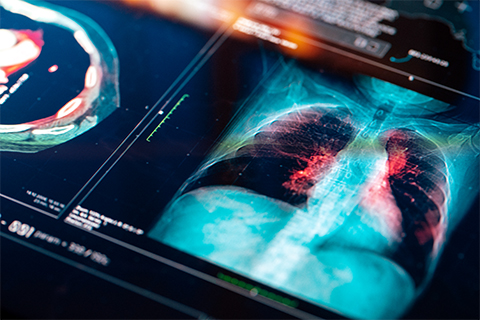From the journals: JBC
Lung cancer cells resist ferroptosis. ORMDL3 in ulcerative colitis. Novel genetic variants in thyroid cancer. Read about papers on these topics recently published in the Journal of Biological Chemistry.
Lung cancer cells resist ferroptosis

Nonsmall cell lung cancer, or NSCLC, is the leading cause of cancer-related deaths. According to the World Cancer Research Fund International, more than 2.2 million new cases of lung cancer were identified in 2020. Therefore, more research on lung cancer progression and resistance to therapy is needed. RNA methyltransferase 2, or NSUN2, catalyzes the methylation of cytosine to 5-methylcytosine m5C, an important epigenetic modification. In addition, NSUN2 has previously been implicated in many types of cancers as it promotes RNA stability and translation, which can lead to cancer cell proliferation. Ferroptosis is a form of cell death that employs free iron to generate toxic reactive oxygen species inside cells and can act as a tumor suppression mechanism.
In a recent article published in the Journal of Biological Chemistry, Youming Chen and Zuli Jiang from Zhengzhou University, along with a team of researchers in China, found that NSUN2 drives ferroptosis resistance in NSCLC. The authors evaluated NSUN2 expression in human NSCLC tumors and normal tissues and showed that NSUN2 levels positively correlated to tumor grade and size.
Using a gene-silencing technique, the authors also showed that NSUN2 deficiency suppressed NSCLC progression in cell culture and increased cancer cells’ susceptibility to ferroptosis. Overexpression of NSUN2-mediated m5C modifications in cancer cells activates the NRF2 transcription factor, which regulates oxidative stress and ferroptosis. Therefore, NSUN2 mutations that lead to overexpression could lead to chemoresistant tumors.
NRF2 inhibitors are used to treat cancer, and this study defined an NSUN2–NRF2 axis. However, further research is needed to identify drugs that exploit this pathway and could sensitize NSCLC to ferroptosis.
ORMDL3 in ulcerative colitis
According to a study published in The Lancet, over five million people suffer from ulcerative colitis, or UC, worldwide. UC is a chronic inflammatory bowel disease that causes inflammation in the digestive tract. Current UC treatments involve medications, surgery, supportive care and more. Genome-wide association studies have implicated more than 200 UC risk loci, including the orosomucoid-like protein 3/ORMDL sphingolipid biosynthesis regulator 3, or ORMDL3, locus. ORMDL3 regulates sphingolipid biosynthesis and is crucial for cell signaling and the stress response.
In a recent article published in the Journal of Biological Chemistry, Jyotsna Sharma and colleagues at the Central Drug Research Institute in India investigated the role of ORMDL3 in UC pathogenesis. They observed that a subpopulation of severe UC patients’ colonic biopsy samples showed increased expression of ORMDL3 and a proinflammatory cytokine, IL-1b, compared to mild UC patients. The study also revealed that ORMDL3, which mainly localizes to the ER, can be found in mitochondria-associated membranes during inflammatory conditions. At these membrane contacts, the authors showed that ORMDL3 drives inflammation by activating the NLRP3 inflammasome. ORMDL3 knockdown, using short hairpin RNA, reduced inflammation and disease severity in a mouse model of UC. Understanding the function and dynamics of ORMDL3 in UC could highlight new areas of research that may lead to better UC therapeutics.
Novel genetic variants in thyroid cancer
Familial nonmedullary thyroid cancer, or FNMTC, comprises 5% to 15% of nonmedullary thyroid cancer cases. FNMTC patients often present with benign lesions, but papillary thyroid cancer, or PTC, is the most frequent subtype observed. The genetic basis of syndromic FNMTC, which affects first-degree relatives, is well-defined; however, researchers do not understand nonsyndromic FNMTC well. Although many germline variants are reported for FNMTC, scientists have not found a genetic cause for nonsyndromic FNMTC.
In an article published in the Journal of Biological Chemistry, Carolina Pires of the Portuguese Oncology Institute and a team of researchers in Portugal identified CHEK2, a tumor suppressor gene, which is overexpressed in patient FNMTC cells. The authors sequenced 94 genes associated with cancer predisposition in two unrelated FNMTC families and found two novel germline variants in CHEK2. A kinase assay on the two variants showed that both CHK2 protein variants had lower enzymatic activity compared to the wild-type protein. Furthermore, the authors performed molecular dynamics simulations and circular dichroism and found no distinct structural changes in the CHK2 protein variants. However, immunohistochemical analysis showed that the CHEK2 mutations cause CHK2 protein overexpression in patient tumors.
These results provide a preliminary understanding of the disease pathogenesis but require follow-up studies on additional patients. Concurrently, researching mutant CHK2 inhibitors could also be valuable for FNMTC treatment.
Enjoy reading ASBMB Today?
Become a member to receive the print edition four times a year and the digital edition monthly.
Learn moreGet the latest from ASBMB Today
Enter your email address, and we’ll send you a weekly email with recent articles, interviews and more.
Latest in Science
Science highlights or most popular articles

Using DNA barcodes to capture local biodiversity
Undergraduate at the University of California, Santa Barbara, leads citizen science initiative to engage the public in DNA barcoding to catalog local biodiversity, fostering community involvement in science.

Targeting Toxoplasma parasites and their protein accomplices
Researchers identify that a Toxoplasma gondii enzyme drives parasite's survival. Read more about this recent study from the Journal of Lipid Research.

Scavenger protein receptor aids the transport of lipoproteins
Scientists elucidated how two major splice variants of scavenger receptors affect cellular localization in endothelial cells. Read more about this recent study from the Journal of Lipid Research.

Fat cells are a culprit in osteoporosis
Scientists reveal that lipid transfer from bone marrow adipocytes to osteoblasts impairs bone formation by downregulating osteogenic proteins and inducing ferroptosis. Read more about this recent study from the Journal of Lipid Research.

Unraveling oncogenesis: What makes cancer tick?
Learn about the ASBMB 2025 symposium on oncogenic hubs: chromatin regulatory and transcriptional complexes in cancer.

Exploring lipid metabolism: A journey through time and innovation
Recent lipid metabolism research has unveiled critical insights into lipid–protein interactions, offering potential therapeutic targets for metabolic and neurodegenerative diseases. Check out the latest in lipid science at the ASBMB annual meeting.

